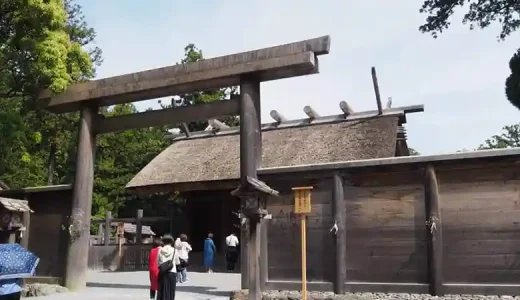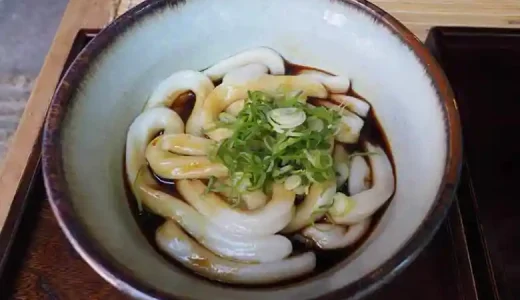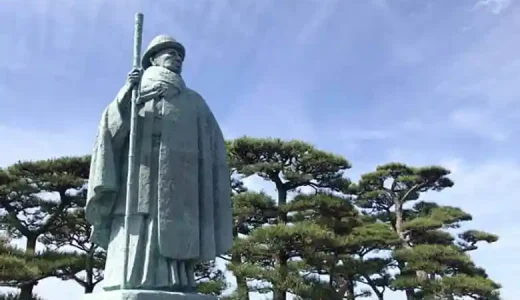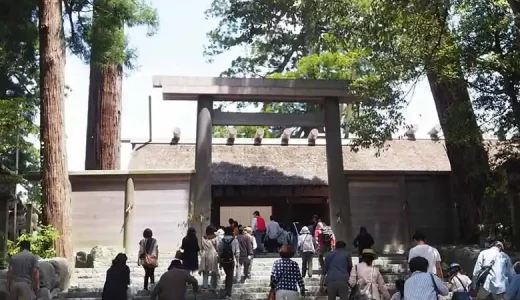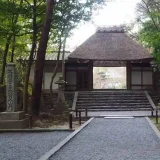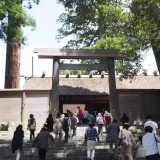I recently visited Ise Grand Shrine in Ise, Mie Prefecture, Japan. This shrine is one of the oldest and most prestigious in the country and has a unique set of rules for worship. In this article, I will share the manners and etiquette I learned during my visit to the Ise Grand Shrine.
Ise Grand Shrine (伊勢神宮, Ise Jingū)
IIse Grand Shrine consists of the main shrines, Naiku and Geku, and other attached shrines, totaling 125. At Ise Grand Shrine, the pavilions of the Naiku and Geku and 14 separate shrines are rebuilt on an adjacent site every 20 years. At the same time, the sacred body of the deity moves to a new shrine pavilion. This rebuilding of shrine pavilions is a system called “Shikinen Sengu.” The first relocation occurred in 690 for Naiku and 692 for Geku. The 2013 relocation was the 62nd.
The picture below depicts the land adjacent to Geku. This area is the same shape and size as the current Geku.
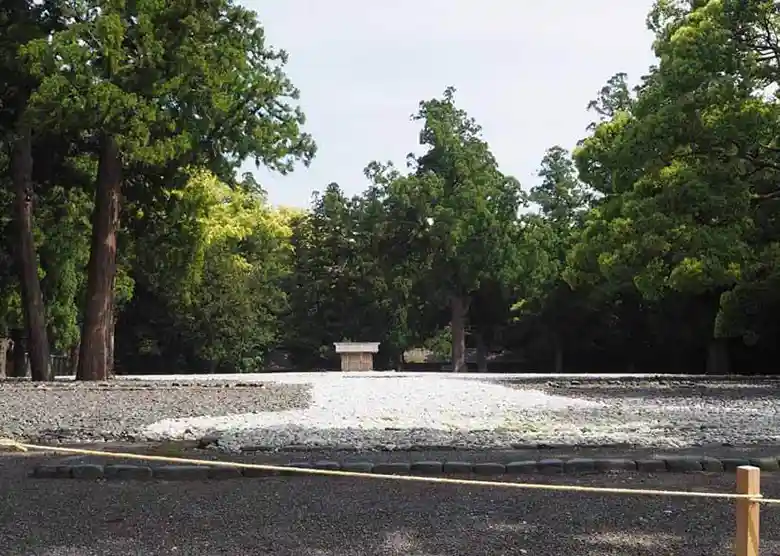
In the next relocation of the shrine, a new shrine pavilion will be constructed where the wooden hut currently stands.
Manners and Etiquette for Worship
Worship Geku first.
t Geku first and then at Naiku. This rule is according to the command of the goddess Amaterasu-Omikami, who is revered at Naiku. She commanded, “When you serve at a festival, worship Geku, which enshrines the deity of fertility, first, and then Naiku, which enshrines me.” Geku enshrines a goddess named Toyouke-no-Omikami. She presides over food and grain.
When you visit Ise Grand Shrine, you should first see Geku. At Geku, it is a rule always to visit the Shogu first. The Shogu of Geku is a shrine dedicated to Toyouke-no-Omikami. After visiting the Shogu, you can see the other shrines. It is important not to visit only the shrines other than the Shogu. The method of worship at Naiku is the same. It would be best to see the Shogu first and then the different shrines. The Shogu of Naiku is a shrine dedicated to Amaterasu-Omikami.
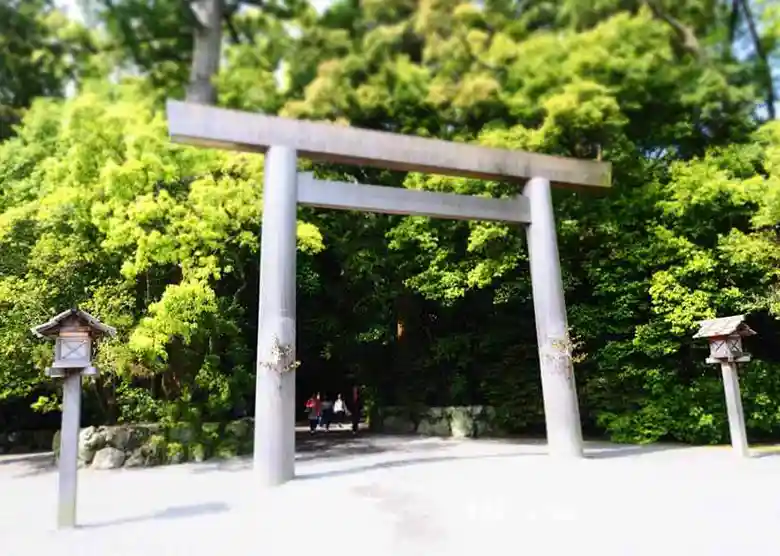
The picture above shows a wooden Torii gate. Do you know how to distinguish between a shrine and a temple in Japan? Shrines have a Torii gate at the entrance, while temples do not have Torii gates but have gate doors instead.
When you pass through the Torii gate, you enter the “sacred space” of the shrine from the “secular world” in which we live. This moment marks the beginning of a spiritual dialogue with God in our hearts. As a sign of respect, we always stop and bow before passing through the Torii gate. When leaving the temple after visiting, remember to turn around and bend towards the shrine as you exit through the Torii gate.
Visit both Geku and Naiku.
Visiting only one shrine, Geku or Naiku, is called “Kata Mairi.” This method of worship is considered unlucky. Be sure to see both Geku and Naiku.
Give thanks to God.
Since the Heian period (794-1185), only the emperor was allowed to make offerings and wishes at Ise Grand Shrine. This rule has become a formality, but even today, at Shogu, it is considered inappropriate to wish for monetary gain or personal wishes. Instead, make your wish at the affiliated shrines other than the Shogu. You can make your request at Taka no miya in Geku and at Aramatsuri-no-miya in Naiku.
Stay away from the center of the approach to the shrine.
Only the gods pass through the center of the path. At Geku, walk on the left side of the course, and at Naiku, walk on the right side.
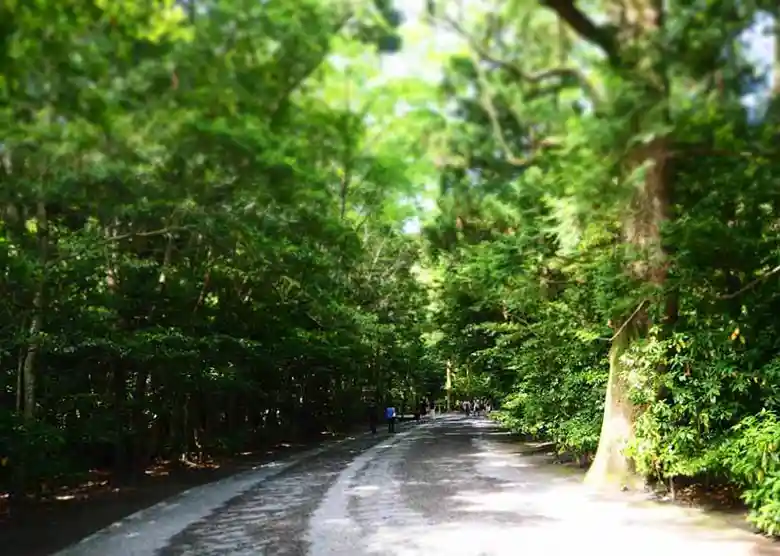
The photo above shows the approach to Geku of Ise Grand Shrine. The middle of the path is reserved for the gods.
Manners of Temizu
Temizu is a ritual where visitors purify themselves by washing their hands and rinsing their mouths with clean water before entering the main shrine.
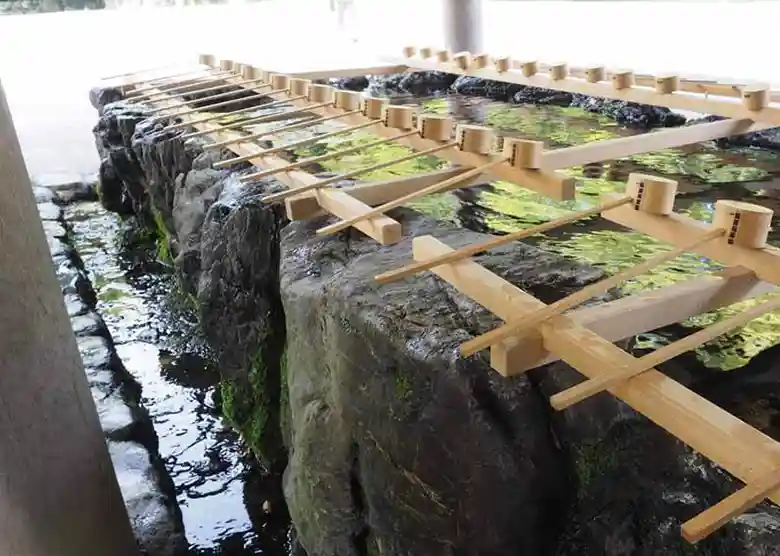
The photo above shows the Temizusha at Geku of Ise Grand Shrine. Worshippers use a dipper to scoop water from the Temizusha and purify their hands and mouths.
- Hold the dipper in your right hand and fill it with water to cleanse your left hand.
- Then, switch the dipper to your left hand and wash your right hand with it.
- Next, hold the dipper in your right hand again, pour the water with your left hand, and rinse your mouth with the water.
- After that, cleanse your left hand again using the dipper.
- Finally, wash the dipper’s handle with the remaining water and return it to its original position.
The following actions are prohibited at Temizu.
- Do not put your mouth on the dipper.
- Do not put water back into the Temizusha after rinsing your hands or mouth.
- Do not gargle with the water in the dipper!
- Rinse your hands and mouth with one cup of water from the dipper.
At Naiku, visitors can also purify their hands with water from the Isuzu River.
How to pray to God(Two bows, two claps, and a bow)
When you arrive at a shrine, pray to the deity in the following manner.
- Stand at the front of the shrine and straighten your posture.
- Bow deeply twice, bending at the waist to a 90-degree angle.
- Clap twice, bringing your hands together at chest level and then separating them to about shoulder-width apart.
- Pray with all your heart and soul.
- Bow deeply again to show your gratitude to the deity.
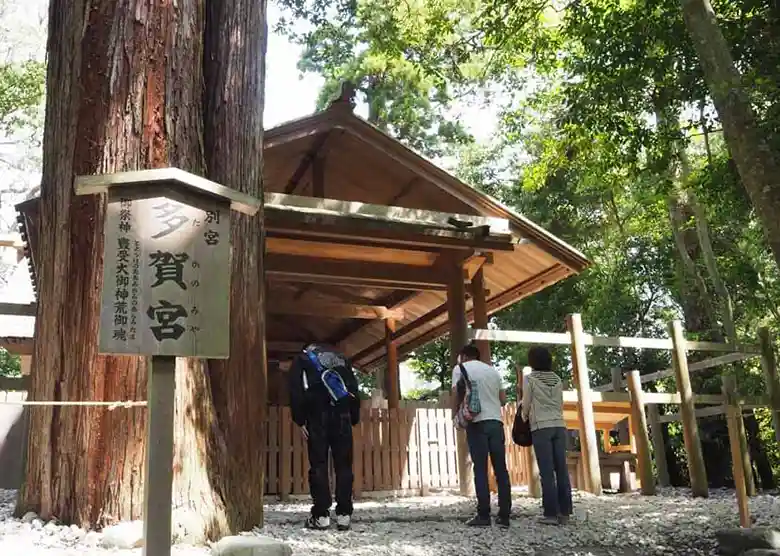
Geku – the outer shrine
The Geku was built around 1,500 years ago to welcome Toyoke-Omikami, the deity responsible for providing meals for Amaterasu-Omikami.
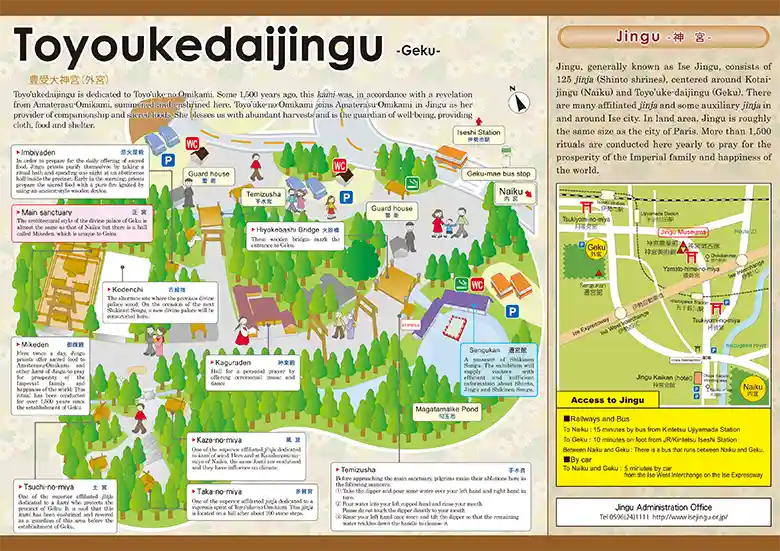
It takes about 1 hour and 20 minutes to reach Geku from Nagoya by taking the Kintetsu limited express and getting off at Ise-shi Station. From there, it’s a 5-minute walk along the approach to the shrine. The sacred area of Geku spans 89 hectares and contains 32 shrines.
Hiyokebashi Bridge
At the entrance of the bridge, there is a signboard that says, “Passage on the left.
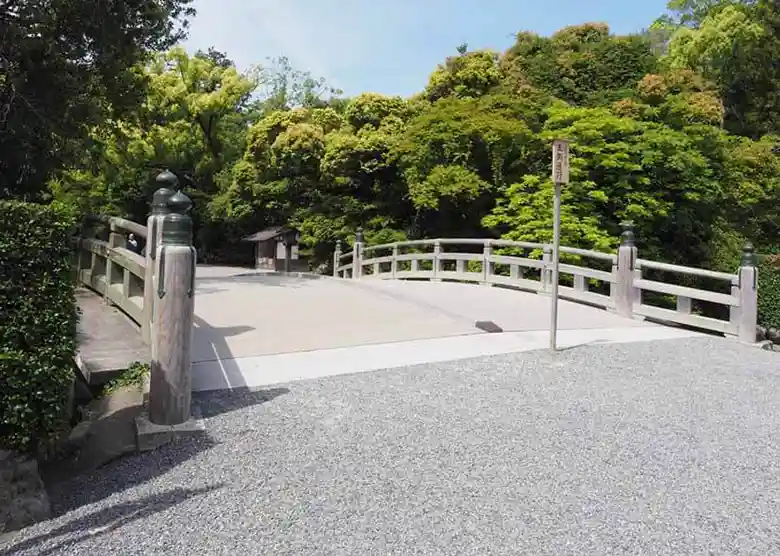
At the bridge entrance, there is a signboard that says, “Pass on the left. From this point forward, worshippers must pass on the left side of the road, as the deities pass in the center of the path.”
Toyouke Daijingu, the Shogu of Geku
The Shogu of Geku is dedicated to a goddess named Toyouke-no-Omikami. This goddess is the guardian of food, clothing, shelter, and industry and presides over the meals of Amaterasu-Omikami.
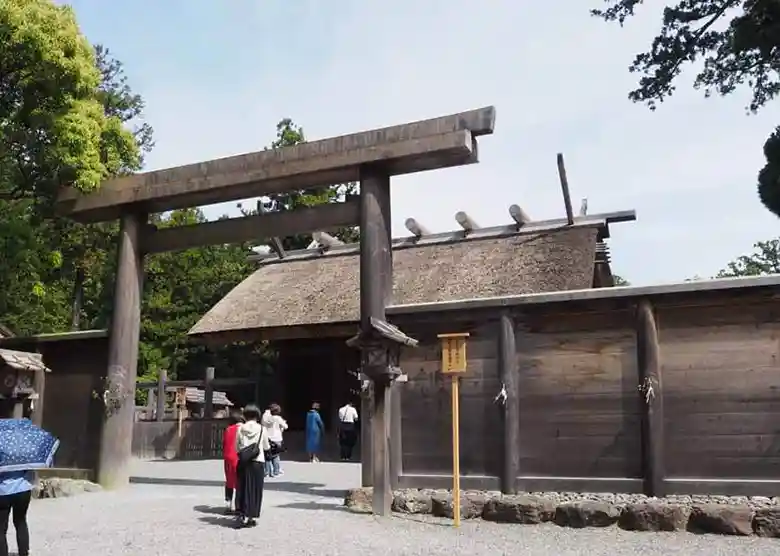
The board fences surround the Shogu, and the entrance is covered with a pure white silk ledger, so visitors cannot see inside the building.
I visited the Shogu first, and then I saw other shrines and strolled through the forest of Geku.
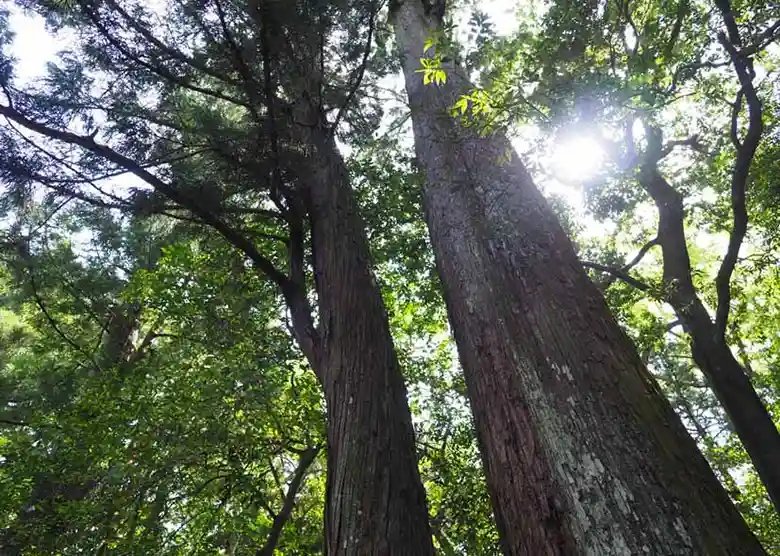
Cutting down trees is forbidden in the sacred area of Ise Grand Shrine, so several hundred-year-old giant trees tower on both sides of the approach to the shrines. I could hear the rustling of leaves and birds chirping and felt one with nature. Immersing myself in nature refreshed my mind and body.
I was able to tour the highlights of Geku in about an hour. I visited early in the morning when there were fewer worshippers, so I could fully enjoy the natural beauty of Geku. If you travel to Japan, visit Ise Grand Shrine early in the morning.
When visiting Ise Grand Shrine, take the time to thank God for all that you have.
- Start by visiting Geku, then move on to Naiku.
- At both shrines, be sure to visit the Shogu first.
- As you approach the shrine, keep to the left side of the path at Geku and the right side at Naiku, as these are the pathways reserved for the gods.
Be sure to observe proper manners and respect the solemn atmosphere of the shrine. Enjoy your visit and take in the beautiful natural surroundings.
